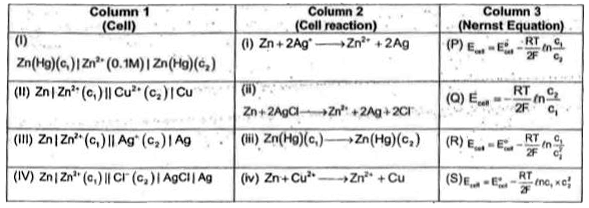In electrolyte concentration cell:
the electrode material and the solution in both half-cells are composed of the same substances
only the concentrations of solutions of ther same substances is different
E∘cell=0
the Nernst equations reduces to Ecell=−(0.0591n) log Q at 25∘C
The correct Answer is:A, B, C, D
To solve the question regarding the electrolyte concentration cell, we will analyze each of the four options provided and determine their validity step by step.
1. Understanding the Electrolyte Concentration Cell:
- An electrolyte concentration cell consists of two half-cells that contain the same electrode material but different concentrations of the same electrolyte solution. For example, both half-cells could use copper (Cu) electrodes immersed in copper sulfate (CuSO4) solutions of different concentrations.
2. Analyzing Option A:
- Statement: "The electrode material and the solution in both half-cells are composed of the same substances."
- Evaluation: This statement is true because, in an electrolyte concentration cell, both half-cells use the same electrode material (e.g., Cu) and the same electrolyte (e.g., CuSO4).
- Conclusion: Option A is correct.
3. Analyzing Option B:
- Statement: "Only the concentrations of the solution of the same substance is different."
- Evaluation: This statement is also true. The key feature of an electrolyte concentration cell is that while the electrode materials are the same, the concentrations of the electrolytic solutions differ, creating a potential difference.
- Conclusion: Option B is correct.
4. Analyzing Option C:
- Statement: "E_cell = E°_cell = 0."
- Evaluation: This statement is true. Since both half-cells consist of the same material, the standard cell potential (E°_cell) is zero. The potential difference arises solely due to the concentration difference.
- Conclusion: Option C is correct.
5. Analyzing Option D:
- Statement: "The Nernst equation reduces to E_cell = -0.0591/n * log Q."
- Evaluation: The Nernst equation is given by E_cell = E°_cell - (0.0591/n) * log Q. Since E°_cell = 0 for this cell, the equation simplifies to E_cell = - (0.0591/n) * log Q, which is consistent with the statement provided.
- Conclusion: Option D is correct.
Final Conclusion:
All four options (A, B, C, and D) are correct regarding the characteristics of an electrolyte concentration cell.
- An electrolyte concentration cell consists of two half-cells that contain the same electrode material but different concentrations of the same electrolyte solution. For example, both half-cells could use copper (Cu) electrodes immersed in copper sulfate (CuSO4) solutions of different concentrations.
- Statement: "The electrode material and the solution in both half-cells are composed of the same substances."
- Evaluation: This statement is true because, in an electrolyte concentration cell, both half-cells use the same electrode material (e.g., Cu) and the same electrolyte (e.g., CuSO4).
- Conclusion: Option A is correct.
- Statement: "Only the concentrations of the solution of the same substance is different."
- Evaluation: This statement is also true. The key feature of an electrolyte concentration cell is that while the electrode materials are the same, the concentrations of the electrolytic solutions differ, creating a potential difference.
- Conclusion: Option B is correct.
- Statement: "E_cell = E°_cell = 0."
- Evaluation: This statement is true. Since both half-cells consist of the same material, the standard cell potential (E°_cell) is zero. The potential difference arises solely due to the concentration difference.
- Conclusion: Option C is correct.
- Statement: "The Nernst equation reduces to E_cell = -0.0591/n * log Q."
- Evaluation: The Nernst equation is given by E_cell = E°_cell - (0.0591/n) * log Q. Since E°_cell = 0 for this cell, the equation simplifies to E_cell = - (0.0591/n) * log Q, which is consistent with the statement provided.
- Conclusion: Option D is correct.
All four options (A, B, C, and D) are correct regarding the characteristics of an electrolyte concentration cell.
Topper's Solved these Questions
- ELECTROCHEMISTRYBOOK - NARENDRA AWASTHI ENGLISHCHAPTER - ELECTROCHEMISTRYEXERCISE - Match the column
6 Videos
- ELECTROCHEMISTRYBOOK - NARENDRA AWASTHI ENGLISHCHAPTER - ELECTROCHEMISTRYEXERCISE - Assertion Reason type question
15 Videos
- ELECTROCHEMISTRYBOOK - NARENDRA AWASTHI ENGLISHCHAPTER - ELECTROCHEMISTRYEXERCISE - LEVEL-2
28 Videos
- DILUTE SOLUTIONBOOK - NARENDRA AWASTHI ENGLISHCHAPTER - DILUTE SOLUTIONEXERCISE - leval-03
23 Videos
- GASEOUS STATEBOOK - NARENDRA AWASTHI ENGLISHCHAPTER - GASEOUS STATEEXERCISE - Subjective problems
15 Videos
Similar Questions
Resistance of a conductivity cell filled with a solution of an electrolyte of concentration 0.1 M is (100Ω) . The conductivity of this solution is 1.29sm−1. Resistance of the same cell when filled with 0.2 M of the same solution is 520Ω . The molar conductivity of (0.02)M solution of the electrolyte will be :
View SolutionResistance of a conductivity cell filled with a solution of an electrolyte of concentration 0.1 M is 100Ω. The conductivity of this solution
is 1.29 Sm−1 . Resistance of the same cell when filled with 0.2 M of the same solution is 520Ω . The molar conductivity of 0.2 M solution of the electrolyte will be :
View SolutionWhich does not represent a concentration cell?
View SolutionThe specific conductance (K) of an electrolyte of 0.1 N concentration is related to equivalent conductance (∧aq) by the following formula.
View SolutionFind the EMF of the concentration cell represented as given below:

View Solution
Which of the following combination is correct for concentration cell?
View SolutionIn the given figure the electrolytic cell contains 1L of an aqueous 1M Copper (II) sulphate solution. If 0.4 mole of electrons passed through of cell, the concentration of copper ion after passage of the charge will be

View SolutionHow will you come to know whether the concentration of electrolyte has fallen down or not?
View SolutionWhat will be PH of aqueous solution of electrolyte in electrolytic cell during electrolysis of CuSO4(Aq) between graphite electrodes ?
View SolutionWhich of the following are concentration cell?
View Solution
